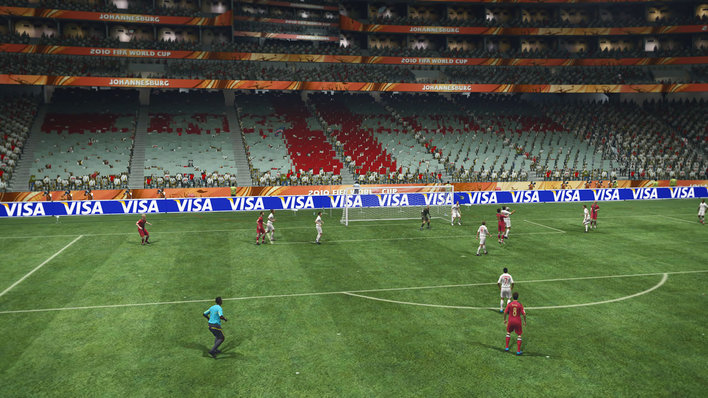You can always tell when it gets to this time of the (four) year(s). The tacky little England flags start popping up on cars, the St George's cross gets draped from windows, across shirts, and even more disturbingly, across fat people's beer bellies. Yes, it's the World Cup - and with every major international football tournament, comes the major international football game, which this year is known as the 2010 FIFA World Cup South Africa.
And while we remember the days of the old top-down, pixelated football games with a knowing smile, 2010 FIFA World Cup is real reminder of just how far things have come since then. Every aspect of the world's biggest sporting competition is faithfully recreated here - which is no mean feat, seeing as the game came out before the tournament even began. With goalkeepers fumbling the balls, fouls being given every ten seconds for the slightest of knocks, and, yes, even the now-iconic vuvuzelas included, you could be forgiven for thinking you're watching the real thing, and it's hard not to get caught up in the World Cup atmosphere.

Will it happen? We've got to get through Germany first.
If you've played a football game in recent years - especially if you've played it against someone who's more experienced, we wouldn't blame you for feeling a bit put off. Over the past few instalments, football games - specifically FIFA games in general have been going for the jugular of the armchair managers - a strategy that's paid off, with each and every instalment seeing bigger and more impressive sales figures, but also one that's left a lot of players feeling somewhat alienated. If you don't follow football passionately, FIFA games are often very confusing things - a mishmash of whistles blowing, people randomly stopping the ball, and a rather confusing control scheme.
Thankfully, 2010 FIFA World Cup has tried to address the balance with the introduction of two button mode, something we covered in detail in an earlier preview. If you were to try and play using any of the other control schemes, there's actually a legitimate five pages of buttons to remember if you want to be able to actually beat anybody who plays online. If you turn two button mode on, you only have to worry about two - A to pass, and B to shoot.
And thankfully, with a few exceptions, the mode really does work. It levels the playing field, it makes the game a lot simpler, and leaves you to concentrate on the more important things - like trying to work out where your players are. You don't even really have to worry about charging up shots any more (you used to have to hold the B button down to determine the force behind your shot) - but two button mode seems to do this for you. While there are a few times the mode falls short - specifically, it seems to have an aversion to letting you pass the ball across the goalmouth, preferring instead to boot it high up in the air (usually over your team's heads), and a tendency to take shots with all the power of a star striker for the Craggy Island All-Priests Over 75 5-a-side team, for the most part, the control scheme works, and works well, taking great strides towards making FIFA games in general much more accessible.

Unfortunately, you find yourself giving away a few too many free kicks...
If you were worried the game would be somewhat limited, thanks to only featuring the one tournament, the developers have done plenty to allay your fears, by including more modes than you could shake a Frenchman's handball at.
Starting with the basics is the World Cup mode, which lets you pick your team from one of 199(!) teams that took part in the qualification phases, before trying your best to guide them to glory on the grandest stage. Letting you choose to either play through the qualifying phases, or simply dive in where it gets interesting as the tournament kicks off proper, the standard World Cup mode is just the beginning.
There's also the Captain your Country mode, which not only puts you in the boots of a single player on a team, but also locks you in them as well. Most of the time, football games automatically change your player to be whoever's nearest to the ball at the time, but in Captain your Country mode, you're forced to stay as the one player, as you compete with the rest of the team to earn the captain's armband. How do you do this, you ask? Simply by playing "well", although FIFA's definition of "well", and our definition of "well" are two markedly different things.

Despite trying to attract new players, it's still rather tricky to tell who you're playing as - why won't they give you the option of a more obvious player indicator?
Captain your Country is almost actively geared against novices simply through a lack of explanation. Your player has a score bar at the bottom of the screen, and as you progress through the match, this will fluctuate, depending on how well you're playing. The only problem is, when you do things wrong, it doesn't actually tell you what you're doing. All you'll see is your bar go red, as you try to work out quite what the game's penalising you for. Standing out of position, or performing a cross that doesn't reach one of your team mates are common things to be penalised for - but when you're getting points taken off for the moves the two button mode's deciding to do (kicking the ball in the air rather than keeping it low, or performing the wrong type of shot), it doesn't feel very fair - and as it doesn't tell you what you're doing wrong, you can't correct your mistakes.
In general, too, the actual football in the game still seems geared towards the football hardcore. As a potent example, let's look at fouls. When you commit a foul, the game always used to pause, show you a replay, and then let the other team take the resultant free kick. Now, the game includes so called quick-free kicks, which usually involve the ref blowing his whistle, and your players suddenly stopping running while the other team put their hand on the ball and play on. It's all very confusing - especially when the game doesn't show you what caused the foul in the first place, which again makes it something you can't try and correct.
It maybe wouldn't be as bad if fouls didn't happen quite so often - but they do, and when they happen, they often don't feel like they're your fault. You can press A to attempt to tackle the ball away from someone, and in a game as advanced as FIFA - especially when you're playing using the two button mode, you could be forgiven for expecting the AI to, you know, think. Instead, rather than sitting back, and waiting for an opportune moment to steal the ball away, as you no doubt expect them to, your player practically steam rolls your opponent, knocking them down, elbowing them out the way, or otherwise legging them up. You don't want them to do it then, and you can't see where their legs are anyway, because the camera's so zoomed out, but they just stick their foot in as soon as you press the button.
If only your players were this responsive at other times. When you tear towards the goal line, hammering B, only for your person to not respond in the slightest - or pressing A to call for a pass, at the same moment your friend decides to pass to you, then watching in bewilderment as the game decides you must have wanted to pass the ball as soon as it touched your foot, leaving you to gently nudge the ball towards the opposition, it gets more than a little bit frustrating. Thankfully, the two button controls really do their bit to counter this out, as all the fancy shots you see experienced players performing are now available to you as a single button press, but it's still a frustrating thing to have happen.

Will England score? Probably not.
In the second biggest improvement for this game (after two button mode), the game will actually update itself as the tournament goes on, in what's known as the Story of the Finals. This is an amazing idea that sees the game giving you new challenges, based on matches that actually happened, as the tournament progresses. To give you an example at the moment, if you weren't happy with England's 1-1 draw with the USA, the game challenges you to go into that match, over half way through, just after Capello's made a substitution, and put things right. Each match has three objectives, and each can be earned individually - in this scenario, the goals are for not conceding, winning, and winning by two goals.
It's an amazing idea, and one that'll have you turning on the game every day (or at least after every England game) as you try to succeed where England, or your other favourite teams, failed.
But it's frustrating, then, that in a game that tries in other areas to be more user friendly, the Story of the Finals mode locks practically all of the matches to the highest difficulty levels. While on most of the scenarios, you can choose the difficulty you want to play at, on most of the challenges, you can only choose between the hardest two - meaning this entire mode is basically inaccessible for new players, or people like us, who aren't really that good, and don't want the frustration. Why they didn't let you change the difficulty is completely beyond us - why you'd effectively lock one of the main selling points of the game for anyone but the elite is seemingly entirely counter-productive, especially in a game that's done more than any football game before it to open itself to the non-hardcore crowd.
It's not that any of these are real game breaking problems, either - it's just so frustrating that, in a year when EA decided to try and make their game appeal to the masses, so much of it seems to work against them. If EA were to contact us, we could give them a large list of things that would make the game more accessible to the casual player - and we really wish they would, as these are all tiny things, that come together to make a big difference.
2010 FIFA World Cup lets you take on the world, and makes it simultaneously both easier, and more frustrating for you to do so. It gives you two button mode, which lets anyone pick up and play - but then makes tackling so stupid, you find yourself giving away fouls every few minutes. It adds an incredible mode that lets you avenge your favourite teams losses, and then stops you from playing it, unless you're one of the best.
It's thrilling and frustrating, at times exhilarating, and sometimes almost equally unfair. Like the real thing, then, 2010 FIFA World Cup is a game of two halves.
Format Reviewed: Xbox 360




















